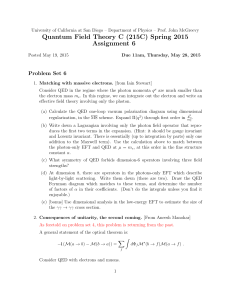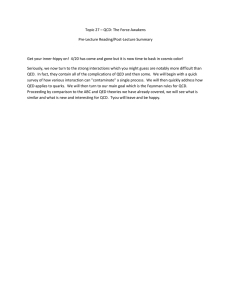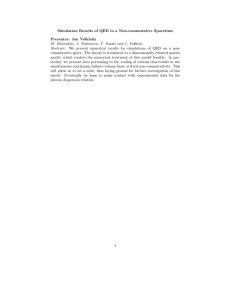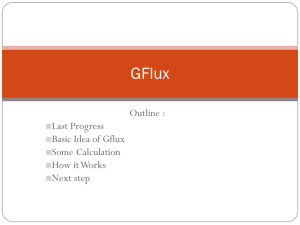The Magnetic Moment of the Electron
advertisement
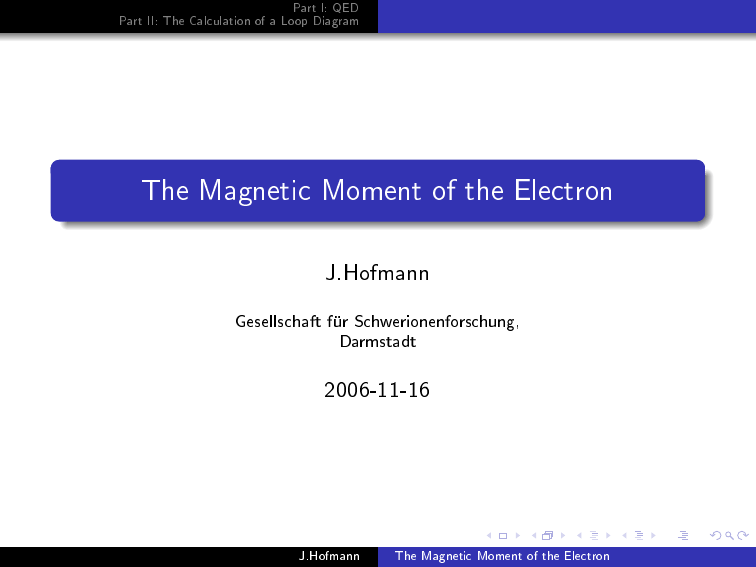
Part I: QED
Part II: The Calculation of a Loop Diagram
The Magnetic Moment of the Electron
J.Hofmann
Gesellschaft f
ur Schwerionenforschung,
Darmstadt
2006-11-16
J.Hofmann
The Magnetic Moment of the Electron
Part I: QED
Part II: The Calculation of a Loop Diagram
Motivation
The g -factor classically
Consider a charge ying in circles
=I a
v
I =q =
2q r q ; jaj = r
) = g 2 m L where g = 1 :
The g -factor in quantum mechanics:
The Dirac equation
(i @/ eA/ m) = 0
gives g = 2. Can we do better?
2
J.Hofmann
The Magnetic Moment of the Electron
Part I: QED
Part II: The Calculation of a Loop Diagram
Outline
Part I { The QED Lagrangian
The QED Lagrangian
Free theory
Gauge symmetry
Feynman diagrams
Part II { Calculation of g
Feynman parameters
Wick rotation
Calculating g
Conventions
Peskin & Schroeder (especially ~ = c = 1 and p/ = p)
J.Hofmann
The Magnetic Moment of the Electron
Part I: QED
Part II: The Calculation of a Loop Diagram
The QED Lagrangian
The Lagrangian Density
LQED
= i @/ m 1 F F e A
4
; : Electron eld (Dirac spinors)
A : Potential for the electromagentic eld
F = @ A @ A : Electromagentic eld-strength tensor
J.Hofmann
The Magnetic Moment of the Electron
(1)
Part I: QED
Part II: The Calculation of a Loop Diagram
The QED Lagrangian { II
Free electrons
Setting A = 0 the Lagrangian is
L = i@
/ m :
As in classical mechanics, the equation of motion can be derived
with a variational principle. This gives
@L
@
= @ @ (@@L) :
Calculating this one gets the Dirac equation for and !
J.Hofmann
The Magnetic Moment of the Electron
Part I: QED
Part II: The Calculation of a Loop Diagram
The QED Lagrangian { III
Photons in vacuum
Setting = 0 the Lagrangian is
= 14 F F :
The equations of motion can be derived similarly. This gives the
Maxwell equations (in vacuum):
@ F = 0 :
L
J.Hofmann
The Magnetic Moment of the Electron
Part I: QED
Part II: The Calculation of a Loop Diagram
Gauge invariance
Gauge transformations
Classically, a gauge transformation is
@(x )
; A ! A + r(x )
!+
@t
or written in a covariant form:
A ! A + @ (x ) ; ! e
i e (x )
Reminder
1 F F m + (i @ ) e A
4
Only the combination (i @ e A) is gauge invariant!
LQED
=
J.Hofmann
The Magnetic Moment of the Electron
Part I: QED
Part II: The Calculation of a Loop Diagram
Perturbation theory
The interaction
The interaction term couples the equation of motion for the
electrons and the photons:
@ F = e ;
(i @/ m) = e A/ :
How should one deal with that problem? ! Use perturbation
theory: expand in powers of e .
A convenient way to visualise the contributions to this
perturbative expansion is the use of Feynman diagrams.
J.Hofmann
The Magnetic Moment of the Electron
Part I: QED
Part II: The Calculation of a Loop Diagram
Feynman Diagrams
Examples
Building Blocks
J.Hofmann
The Magnetic Moment of the Electron
Part I: QED
Part II: The Calculation of a Loop Diagram
The Photon Propagator I
Reminder: Greens Function for the wave equation
The wave equation is (in Lorentz gauge, @A = 0)
(x ) = (x ) :
A Fourier Transformation gives
1:
k ~(k ) = 1 =) ~(k ) =
2
k2
J.Hofmann
The Magnetic Moment of the Electron
Part I: QED
Part II: The Calculation of a Loop Diagram
The Photon Propagator II
How to treat the pole
Z 1
1
(x ) =
e i k x
dk
k
1
The photon propagator is given by
2
which guarantees causality.
i g k2 + i "
J.Hofmann
The Magnetic Moment of the Electron
Part I: QED
Part II: The Calculation of a Loop Diagram
The Electron Propagator
Greens Function for the Dirac equation
The Fourier transform of the Dirac equation gives
(i @ m)(x ) = (x ) ;
~ (p) = p 1 m :
The electron propagator is given by
i ( p/ + m)
:
p m + i"
2
J.Hofmann
2
The Magnetic Moment of the Electron
Part I: QED
Part II: The Calculation of a Loop Diagram
The Interaction
The Vertex
The interaction part of the Lagrangian is given by
Lint =
e A ;
correspondingly the contribution from a vertex is
i e :
J.Hofmann
The Magnetic Moment of the Electron
Part I: QED
Part II: The Calculation of a Loop Diagram
Part II
Part II
Calculating a Loop Diagram
J.Hofmann
The Magnetic Moment of the Electron
Part I: QED
Part II: The Calculation of a Loop Diagram
The Electron Vertex Function
The full amplitude
The 'scattering amplitude' can be read o:
Z
i g
k
u (p0 )( i e )
4
(2)
(k p )2 + i "
0
k 02i ( k/ m+2m+) i " k 2i ( k/m+2m+) i " ( i e )u(p)
4
d
How to calculate this monster?
J.Hofmann
The Magnetic Moment of the Electron
Part I: QED
Part II: The Calculation of a Loop Diagram
Trick 1: Feynman Parameters I
The idea
To combine two denominators, use the formula
1 = Z dx dy (x + y 1) :
AB
(x A + y B )
The generalisation to Am Am :::Amn n is easy.
1
2
0
1
1
1
2
2
J.Hofmann
The Magnetic Moment of the Electron
Part I: QED
Part II: The Calculation of a Loop Diagram
Trick 1: Feynman Parameters II
Simple example
Consider
Z
1
(x + y 1)
=
dx dy
(k p ) ( k m )
[x (k p) + y (k m )]
Z
(x + y 1)
= dx dy
;
[ r + ( x x )p y m ]
where r = k x p.
Now an integration over d k = d r depends only on r .
1
2
2
2
2
0
2
2
1
2
0
4
J.Hofmann
4
2
2 2
2
2
The Magnetic Moment of the Electron
2
Part I: QED
Part II: The Calculation of a Loop Diagram
Intermediate result I
The Denominator
Combining the three denominators in our original integral gives
Z
2 (x + y + z 1) ;
dx dy dz
1
where
D3
0
= r + i" ;
= k +y q zp;
= x y q + (1 z ) m
Now let's have a look at the nominator!
D
r
2
2
J.Hofmann
2
2
:
The Magnetic Moment of the Electron
Part I: QED
Part II: The Calculation of a Loop Diagram
The Nominator
Form Factors
Due to Lorentz-invariance, the result must be of the form
u (p0 ) A + (p0 + p ) B + q C + q D u (p) :
This must vanish when contracted with q
(no longitudinal photons) ) D = 0 :
Gordon identity (from Dirac equation, = i [ ; ]):
0
p + p i q
0
0
u (p ) u (p ) = u ( p )
2 m + 2 m u (p )
) forget about B .
2
J.Hofmann
The Magnetic Moment of the Electron
Part I: QED
Part II: The Calculation of a Loop Diagram
The Nominator
Form Factors
Finally we get
i q
F2 (q 2 ) u (p) :
2m
It is
g = 2[F1 (0) + F2 (0)] :
Charge conservation gives F1(0) = 1, it remains to calculate F2(0).
u (p0 ) F1 (q 2 ) +
Our case
Here the nominator is
1
u (p0 ) ( r + (1 x )(1 y )q + (1 4z + z )m )
2
+ i 2 mq (2 m (z z ))u(p) :
2
2
2
2
J.Hofmann
2
2
The Magnetic Moment of the Electron
Part I: QED
Part II: The Calculation of a Loop Diagram
Trick 2: Wick Rotation
Prescription
r = rE ;
r 0 = i rE0 ;
4
2 3
dr = 2 r djr j
J.Hofmann
The Magnetic Moment of the Electron
Part I: QED
Part II: The Calculation of a Loop Diagram
Result
Finally. ..
The formfactor is
2 m (z z ) :
1) m (1
z ) q xy
Now it is straight-forward to calculate (J. Schwinger 1948)
g 2
2 = F (0) = 2 0:0011614 :
Experimental Value
The currently accepted PDG g -factor is
g =2 = 1:0011596521859 38 :
F 2 (q
2
)=
2
Z
1
x y z (x + y + z
d d d
0
2
2
2
2
2
J.Hofmann
The Magnetic Moment of the Electron
2
Part I: QED
Part II: The Calculation of a Loop Diagram
Summary
Part 1
The QED-Lagrangian
Feynman Diagrams
Part 2
Draw the diagrams and write down the amplitude
Combine the denominators with Feynman parameters
Shift the momentum so that the denominator only depends on
the squared momentum
Perform the integral via Wick rotation
J.Hofmann
The Magnetic Moment of the Electron
